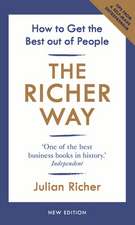Good to Great and the Social Sectors
Autor Jim Collinsen Limba Engleză Paperback – 7 sep 2006
| Toate formatele și edițiile | Preț | Express |
|---|---|---|
| Paperback (2) | 46.00 lei 21-33 zile | +14.10 lei 6-12 zile |
| CORNERSTONE – 7 sep 2006 | 46.00 lei 21-33 zile | +14.10 lei 6-12 zile |
| HarperCollins Publishers – 21 noi 2005 | 89.88 lei 3-5 săpt. |
Preț: 46.00 lei
Preț vechi: 56.03 lei
-18% Nou
8.80€ • 9.16$ • 7.38£
Carte disponibilă
Livrare economică 21 februarie-05 martie
Livrare express 06-12 februarie pentru 24.09 lei
Specificații
ISBN-10: 1905211325
Pagini: 48
Ilustrații: 7 charts and diagrams
Dimensiuni: 154 x 233 x 7 mm
Greutate: 0.1 kg
Editura: CORNERSTONE
Notă biografică
Jim Collins is author or co-author of six books that have sold more than 10 million copies worldwide, including the bestsellers Good to Great, Built to Last, and How the Mighty Fall. Jim began his research and teaching career on the faculty at Stanford Graduate School of Business, where he received the Distinguished Teaching Award in 1992. He now operates a management laboratory in Boulder, Colorado, where he conducts research, teaches, and consults with executives from the corporate and social sectors. More about Jim and his works can be found at his e-teaching site, where he has assembled articles, audio clips, a recommended reading list, discussion guide, tools, and other information. The site is designed to be a place for students to study and learn: www.jimcollins.com.
Descriere
'We must reject the idea - well-intentioned, but dead wrong - that the primary path to greatness in the social sectors is to become "more like a business".' So begins this astonishingly blunt and timely manifesto by leading business thinker Jim Collins. Rejecting the belief, common among politicians, that all would be well in society if only the public sector operated more like the private sector, he sets out a radically new approach to creating successful hospitals, police forces, universities, charities, and other non-profit-making organisations. In the process he rejects many deep-rooted assumptions: that somehow it's possible to measure social bodies in purely financial terms; that they can be managed like traditional businesses; that they can be transformed simply by throwing money at them.
Instead he argues for radical new attitudes and strategies, using the analytical approach and clear thinking that lie at the heart of Good to Great.























